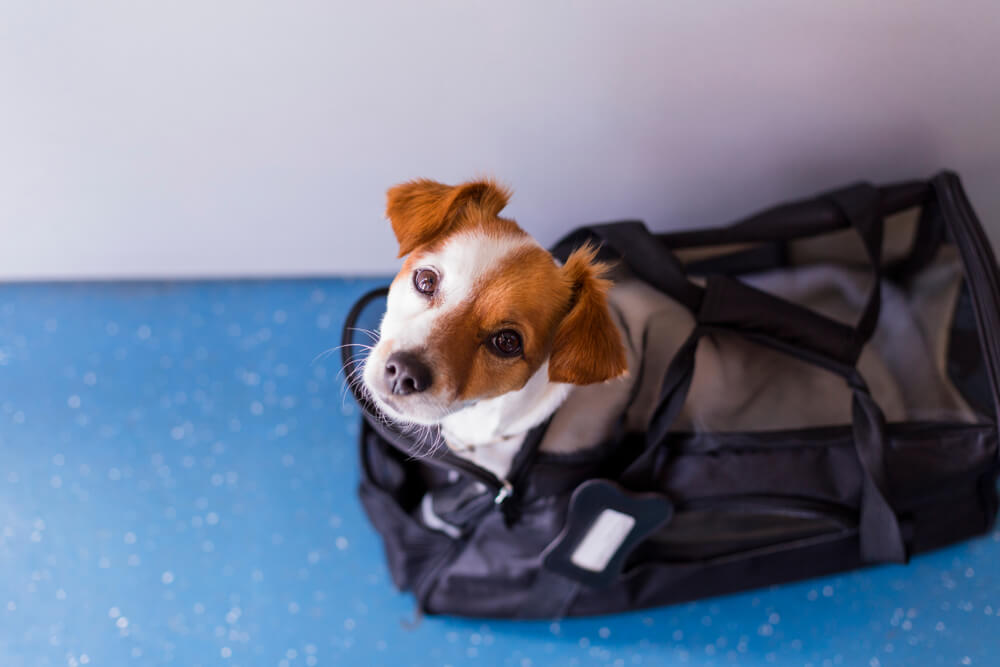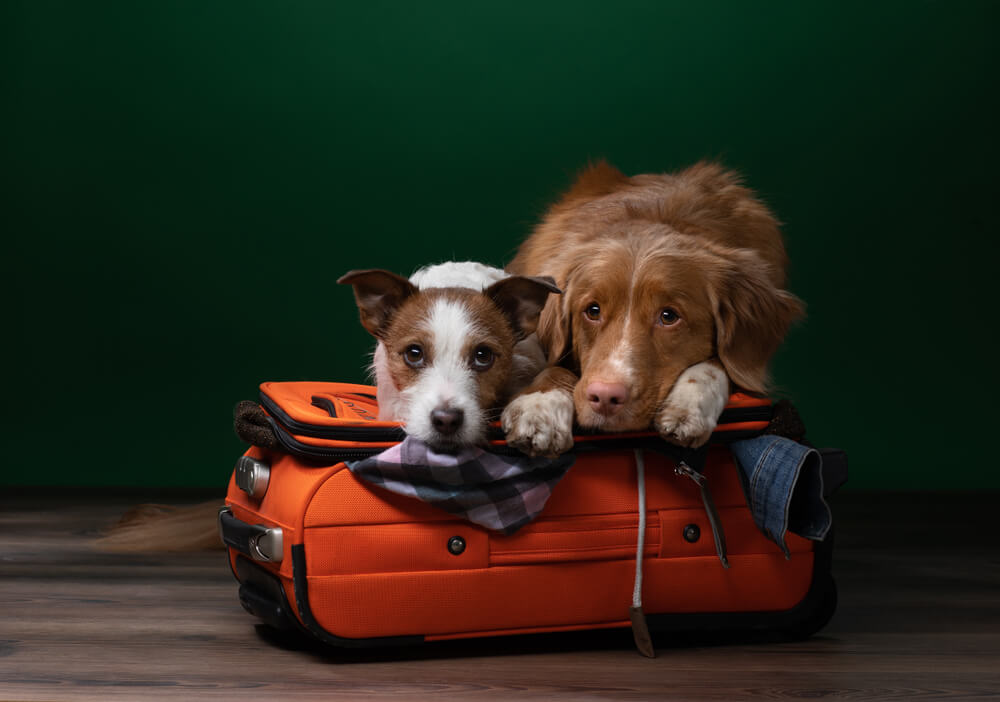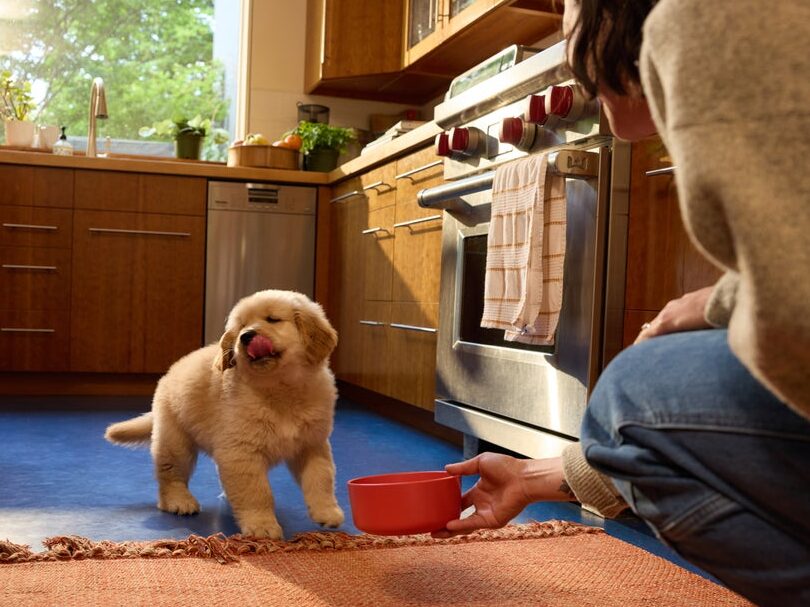Hey Ollie blog readers! We’re offering you an exclusive 60% OFF your starter box! Try now!
You have a larger dog and you might need to travel across the country. You don’t want to leave your pup but you’re concerned about flying with your dog. Don’t worry, we consulted an expert to find out all of your options and how to make air travel as safe and comfortable as possible for your very best friend.
Flying with dogs: the basics
Both Delta and American Airlines, as well as many other airlines, allow small dogs to travel in the cabin for a fee. They must be able to fit in a small, ventilated pet carrier that fits under the seat in front of you. They require that your pet stay in the carrier for the duration of the flight. Note that there is generally a limit to how many pets can travel on each flight. Pets are booked on a first come first served basis so you want to let the airline know ASAP that you are traveling with a dog to increase your chances of being accommodated.
You’ll need to confirm with the airline prior to flying the exact dimensions required for your travel carrier. It can vary from carrier to carrier and even from flight to flight. There are also some age restrictions as well as destination restrictions that vary from carrier to carrier. MAKE SURE TO CHECK WITH THE AIRLINE PRIOR TO TRAVELING WITH YOUR DOG. This is for your pet’s comfort and safety as well as your own.
Larger dogs will need to fly as checked baggage. Each airline has specific requirements you’ll need to follow regarding making the reservation, checking in and how your pup needs to travel. Read them carefully before booking flights and contact the airline ASAP to let them know you’re traveling with your dog. Brachycephalic dogs cannot travel as checked baggage! If you have a pug or other dog with a flat face, you cannot have them travel as checked baggage or cargo. It is simply too risky.
The exception to this is working dogs (police or military), ADA compliant service dogs and emotional support animals (ESAs). Do not get fake paperwork for your dog so that you can fly in the cabin with them. This puts the safety of other passengers and trained service dogs in jeopardy. Should you not be able to control your dog, you risk injuring other passengers or dogs.
According to an article published by NPR, The U.S. Department of Transportation is considering tightening the rules for taking service animals on planes after increased customer complaints and lobbying from the airlines who think current regulations are too lenient.
The Department of Transportation would no longer require airlines to consider emotional support animals to be service animals, as they have in the past. It also would require additional paperwork for service dogs, which some disability advocates find troubling. Whether this legislation goes into effect or not, do not lie about your dog’s training in order to allow them to fly in the cabin!
7 tips for flying with a large dog
While you can never be too prepared to travel with your pet, these 7 tips will help make your experience as positive as possible. If you have questions or concerns about your specific trip contact the airline, your vet or a qualified trainer prior to booking any travel.
-
Visit your vet
Visit your vet and let them know of your travel plans. Depending on the airline and destination, your vet may have to sign that your dog was examined within days of the trip. Check with the airline as well as your dog’s doctor and make sure all of the paperwork is in order. You also want to check to make sure your dog has appropriate vaccines for your destination. Having all of this planned prior to your trip will make things much easier.
-
Invest in a proper crate
Check with the airline to make sure you have a travel crate that is safe and acceptable. Your dog should have enough room to stand up and turn around in the crate.
-
Prepare your dog
Have your pup practice getting into the travel crate. Use rewards and build up their comfort and confidence. Start exposing your dog to the travel crate 4-6 weeks prior to your flight.
-
Create a plan for the day of your trip
Ask your vet about how to feed your dog on the day of your trip. You may not be able to offer your dog a meal less than 4 hours before takeoff. You want to plan accordingly. Make sure you know how to get through security and can give your dog an opportunity to go to the bathroom before the flight. Do not use sedation for your pet as it comes with extra risk as the pressure changes and temperature changes can impact your pup’s heart and lungs.
-
Fly Direct
This will minimize the amount of time and stress on your dog. If you can’t fly direct make sure there is time between flights for your dog to eat, go to the bathroom and destress from the flight. Just like traveling can be uncomfortable for you, it can be stressful and uncomfortable for your dog. This is especially true if your dog has never flown before.
-
Do not fly in extreme temperatures
Most airlines will not allow you to fly with your dog (checked) in extreme weather conditions. If it is too hot or too cold you cannot take your pet with you. Do your research in advance to make sure the temperatures will be safe for your dog.
-
Make sure your pet has proper identification and a working microchip
Before flying make sure your dog has a safe collar with ID and your cell phone number. Also clearly put your information on the travel crate. Finally, be sure to have some updated photos of your pup so that in the unfortunate event you get separated it is easy to share some recent pictures.

Considerations for flying with your dog
“For any of my clients who have flown overseas, I have always had the same thing to say. Get a good crate that CANNOT be broken out of.” Said Robert McLaughlin, the owner of HD Dog Training in Pennsylvania. “Zip tie the corners of the crates or where-ever there are separation points. Personally, I love the metal crates like the ones that Impact crates sells.”
I always ask clients first if they really have to fly with their dogs. I don’t believe that flying is experience dog need in their lives truthfully. Most people cannot properly train their dogs for the experience they will have when flying in cargo.
The HSUS recommends that you weigh all the risks when deciding whether to transport your pet by airplane. Air travel can be particularly dangerous for animals with "pushed in" faces (the medical term is "brachycephalic"), such as bulldogs, pugs and Persian cats. Their short nasal passages leave them especially vulnerable to oxygen deprivation and heat stroke.
They also ask that you consider all the alternatives to flying. If you plan to bring your pet on vacation, driving is usually a better option. If you can’t travel by car, your pet will probably be healthier and happier if you leave them behind under the care of a pet sitter or reputable boarding kennel. But there are times when that won’t be possible and you’ll have to determine whether the benefits of flying outweigh the risks.
The Ollie blog is devoted to helping pet parents lead healthier lives with their pups. If you want to learn more about our fresh, human-grade food, check out MyOllie.com.
Tagged As:

The nutrition your dog needs,
the food they want.

Enjoying our articles? Subscribe our Newsletters and get new articles directly to your inbox
You might also like
13 May 2025
8 MINS READ
Puppy Training Guide & Behavior Timeline
Bringing home a puppy is pure magic. It’s also pure chaos—tiny teeth, zoomies, accidents in the house, and moments that make you wonder if you’re raising a future genius or a tiny tornado. …
by Ollie Pets
10 May 2025
12 MINS READ
New Puppy Checklist: Guide To Prepare For A New Dog
Bringing home a new puppy? This checklist covers everything new dog owners need—from essential supplies to training, feeding, and first vet visits.
by Ollie Pets
3 April 2025
9 MINS READ
Home Remedies for Fleas on Dogs: 10 Natural Ways That Actually Work
Wondering what kills fleas on dogs instantly and naturally? If your pup is scratching like crazy, it may be time to take action. In this guide, we’ll show you the most effective home remedies for…







